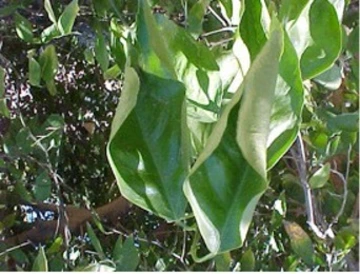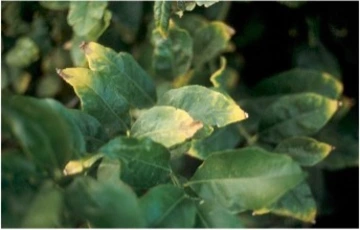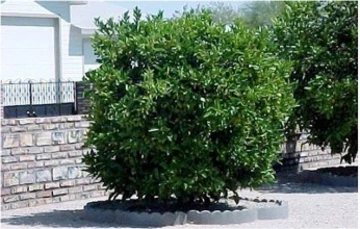Este material también está disponible en español.
Water is essential for citrus trees (or for any plant) because it is an integral component of the biochemical reactions that occur within the plant. Water is also important because it is the carrier that moves plant nutrients and other substances throughout the tree. Water also helps maintain plant temperature through transpiration. Finally, water helps maintain leaf and fruit turgidity.
- The first noticeable sign of water stress in a citrus tree is leaf curling.
- Soil should be wetted from the trunk of the tree to just beyond the drip line, to a depth of at least two feet.
- Citrus should be irrigated every 7 to 28 days depending on season and soil type.
- There are several recommended application methods.
Citrus and water stress
Estimating tree water use
This is the $64,000 question, and the answer depends on tree age, tree size, citrus species, climate and soil type. Research from the University of Arizona has found that mature citrus trees use about 60 inches of water per year. Depending on the size of the tree, this can correspond to as much as 17 gallons of water per day in the winter and 135 gallons of water per day in the summer.
Of course the amount of water applied depends on the time of year. Nevertheless, it is fairly easy to calculate the daily water use if you know canopy diameter of your tree. Daily water use for an orange tree may be found in Table 1. Water use for grapefruit and lemon is about 20 percent higher than that of oranges, while water use for mandarins is about 10% less. Trees planted in grass should receive about 20% more water than trees with no turf or ground cover. Using the table gives a good estimate of the water use for a citrus tree.
Orange tree water requirements
Measure the canopy diameter (drip-line to drip-line) of the tree in feet. Using the left-hand column of the table, find the row that corresponds to the appropriate diameter. Using the upper row of the table, find the column for the month for which you want to calculate tree water use. The daily water use will be the value where the row and column intersect. As an example, a navel orange has a 14-foot canopy diameter. For July, the tree would require 29.5 gallons of water per day.
| Tree canopy diameter (ft) | January | February | March | April | May | June | July | August | September | October | November | December |
|---|---|---|---|---|---|---|---|---|---|---|---|---|
2 | 0.1 | 0.1 | 0.2 | 0.3 | 0.4 | 0.5 | 0.6 | 0.6 | 0.4 | 0.3 | 0.1 | 0.1 |
4 | 0.3 | 0.4 | 0.9 | 1.3 | 1.6 | 2.1 | 2.4 | 2.2 | 1.8 | 1.0 | 0.4 | 0.3 |
6 | 0.7 | 1.0 | 2.1 | 3.0 | 3.6 | 4.7 | 5.4 | 5.1 | 3.9 | 2.3 | 1.0 | 0.7 |
8 | 1.2 | 1.8 | 3.7 | 5.3 | 6.5 | 8.4 | 9.6 | 9.0 | 7.0 | 4.1 | 1.8 | 1.2 |
10 | 1.9 | 2.7 | 5.7 | 8.2 | 10.1 | 13.1 | 15.1 | 14.0 | 11.0 | 6.4 | 2.7 | 1.9 |
12 | 2.7 | 3.9 | 8.3 | 11.8 | 14.6 | 18.9 | 21.7 | 20.2 | 15.8 | 9.2 | 3.9 | 2.7 |
14 | 3.7 | 5.4 | 11.3 | 16.1 | 19.9 | 25.7 | 29.5 | 27.5 | 21.5 | 12.5 | 5.4 | 3.7 |
16 | 4.8 | 7.0 | 14.7 | 21.0 | 25.9 | 33.5 | 38.6 | 35.9 | 28.0 | 16.4 | 7.0 | 4.8 |
18 | 6.1 | 8.9 | 18.6 | 26.6> | 32.8 | 42.4 | 48.8 | 45.5 | 35.5 | 20.7 | 8.9 | 6.1 |
20 | 7.5 | 11.0 | 23.0 | 32.9 | 40.5 | 52.4 | 60.2 | 56.1 | 43.8 | 25.6 | 11.0 | 7.5 |
22 | 9.1 | 13.3 | 27.8 | 39.8 | 49.0 | 63.4 | 72.9 | 67.9 | 53.0 | 31.0 | 13.3 | 9.1 |
24 | 10.8 | 15.8 | 33.1 | 47.3 | 58.4 | 75.4 | 86.7 | 80.8 | 63.1 | 36.9 | 15.8 | 10.8 |
26 | 12.7 | 18.5 | 38.9 | 55.5 | 68.5 | 88.5 | 101.8 | 94.9 | 47.0 | 43.3 | 18.5 | 12.7 |
28 | 14.8 | 21.5 | 45.1 | 64.4 | 79.4 | 102.6 | 118.1 | 110.0 | 85.9 | 50.2 | 21.5 | 14.8 |
30 | 16.9 | 224.6 | 51.7 | 73.9 | 91.2 | 117.8 | 135.5 | 126.3 | 98.6 | 57.6 | 24.6 | 16.9 |
Timing water applications
Despite the fact that values reported in Table 1 are daily water use rates, citrus should not be irrigated daily. Frequent, shallow irrigations will likely mean that not all the roots are actually getting water, and may also increase any salt stress on the tree if salty water is a problem. Appropriate intervals for watering citrus are found in Table 2. These intervals are meant to be guidelines, and should be modified due to local soil conditions, weather conditions or irrigation application methods. Choose the more frequent interval if you have sandy or gravelly soils, choose the less frequent interval for heavier silt or clay soils. Irrigate more frequently during periods of excessively high temperatures and less frequently when temperatures are cooler than normal, or if rainfall has been plentiful. Since drip or microsprinkler emitters provide water to the trees in low volumes, irrigation intervals using these methods must be more frequent. For trees at least three years old, irrigation intervals should be the same as a four month to one-year-old tree under basin or flood irrigation. In all cases, enough water must be applied so that the tree receives sufficient water to the roots before the water evaporates out of the soil. This can be achieved if the wetted soil is shaded, the trees are mulched, or if the trees are deep watered. Soils should always be allowed to dry out to a depth of about 6 inches before the next irrigation. This will limit the problem of soil-borne disease.
Salty water
Application Intervals for Irrigated Citrus Trees
| Time after planting | December-February | March-April | May-June | July-September | October-November |
| 1 to 2 days | 14 to 21 days | 10 to 14 days | 7 to 10 days | 7 to 10 days | 10 to 14 days |
| 0 to 1 months | 2 to 3 days | 2 to 3 days | 2 to 3 days | 2 to 3 days | 2 to 3 days |
| 2 to 3 months | 3 to 5 days | 3 to 5 days | 3 to 5 days | 3 to 5 days | 3 to 5 days |
| 4 months to 1 year2 | 14 days | 7 to 10 days | 5 to 7 days | 2 to 5 days | 5 to days |
| 3 years or older | 21 to 30 days | 14 to 21 days | 14 days | 10 to 14 days | 14 to 21 days |
Calculating how much water is applied
There are two easy methods. First, water application can be measured by looking at a water meter. These meters sometimes measure in cubic feet. One cubic foot of water equals 7.5 gallons. Other meters measure in gallons. Call your municipal water company if you need help reading the meter.
To read the meter at home, first make sure that all other water-using appliances are turned off, including dishwashers and washing machines. Fill two five-gallon containers with water while watching your meter operate. If your meter reads in gallons, then ten gallons use will be indicated on the dial or screen. If your meter reads in cubic feet, then 1.33 cubic feet use will be indicated.
Another method is to turn the garden hose to a given flow and see how many gallons of water go through in one minute. If five gallons go through in one minute, then 150 gallons will be applied if the hose is left on for 30 minutes.
Drip emitters and microsprayers often are rated as to the gallonage they will emit per hour (gph). This rating will be stamped on the sprinkler or emitter body. Gallonage may also be estimated using the water meter. Most or all of the water emitted from a microsprinkler should be applied to the soil under the tree canopy if this method is to be accurate. Gallonage may also be estimated by placing the microsprinkler or drip emitter in a 5-gallon bucket, then estimating the flow rate.
Application methods
Mulches
Mulches might seem to be one of the best ways to conserve irrigation water by maintaining water within the root zone. However, research from the University of California suggests that heavy mulches can lead to soil conditions that promote soil disease. Therefore mulches, other than the leaf litter that falls from the tree, are no longer recommended. Soil temperatures are best lowered and soil moisture best conserved through the shade that is provided when the tree canopy is allowed to grow to the ground.




